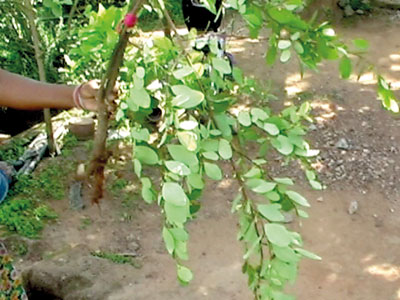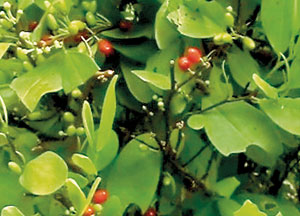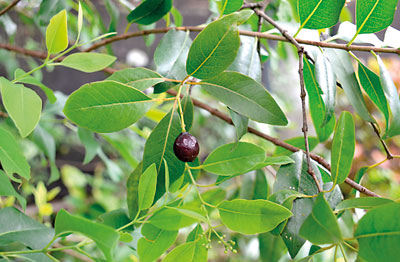Giving root to a deadly mix-up
View(s):They thought they were growing sandalwood trees but now home owners in Matara find they have been nurturing coca trees from which cocaine is derived.
Shaveen Jeewandara reports on this bizarre confusion
What is the price you would have to pay for planting a sandalwood tree- well known for its essential oils used for medicinal purposes- in your home garden? With the weeds of confusion growing far and wide, you may very well have to pay your dues in jail for harbouring narcotics!
The cause of this bizarre confusion is the recent discovery of illegal coca plants, used to derive the psychoactive intoxicant cocaine, which were mistakenly planted as sandalwood trees in the Matara District.

A home garden with the coca plant. Pic by Krishan Jeewaka Jayaruk
Questions are now being raised over whether the Forest Department was in fact responsible for the blunder by distributing the coca plants some years ago, under a project that was supposed to hand out sandalwood seedlings to the residents of the Matara District. If proven, it will be an ignominious slip on the part of the authorities who should have known better. However K. G. Sepala, Divisional Forest Officer of Matara vehemently denies the allegation saying that they distributed other plants of interest under the Divineguma project, but not sandalwood, adding that he had first seen the coca plants in 2001 on a survey of an abandoned plot of land near Akuressa.
The recent discovery of the coca plants came when a group of government officials along with experts from the University of Ruhuna were monitoring the Divineguma cultivation sites to award the prize for the ‘best home garden’ to one lucky grower. A hapless garden-enthusiast had proudly displayed his collection of ‘Sandalwood’ plants, which in reality were coca plants. The discovery was made by Sarath Kumarasinghe, a lecturer attached to the Department of Crop Sciences at the University of Ruhuna, who came to the conclusion that it was not sandalwood as the owner believed but the cocaine producing coca plant.
The officials believe that these plants would have come from private nurseries in the area, and say ornamental plant sellers too have started growing the plant and then putting it on the market- reportedly for about Rs. 500. However many residents said that the plants made their way to their homes through the ‘giving’ hands of the authorities who distributed what they believed were sandalwood plants many years ago.
When contacted, the District Secretary of Matara W.K.K. Atukorale said that all steps have been taken to uproot the cocaine plants from identified sites. “We handled proceedings very carefully in this matter due to the industrious nature of our people. Fortunately for us though, nobody seems to have noticed that their gardens were home to coca plants,” she said adding that they called people in for a meeting where they were taught how to differentiate coca from sandalwood and informed them of the ramifications of illegally harbouring such plants.
She also mentioned a site near Akuressa where some 100 coca plants were growing. Steps had been taken to cut down and destroy them. Several police stations themselves had unknowingly housed the coca plants; but with the recent publicity have ensured that no leaf was left unturned in destroying the plants.
“The coca plant in question is the Erythroxylum novogranatense, which is a neo-tropical species that has its origins in South America, specifically Columbia. Columbia was formerly known as New Granada, hence the Latin translation novogranatense,” said Dr. Cyril Wijesundara, Director General of the National Botanical Gardens.
The plant was in fact brought to the island by the Europeans and the Royal Botanical Gardens has got its first coca plant in 1870. “The Botanical Gardens received the plant for botanical interest, but evidently it has an ornamental value, and can be pruned to different shapes,” Dr. Wijesundara said calling it a ‘pretty’ plant with a red fruit. But looks can be deceiving as it is a beautiful killer.
Speaking to the Sunday Times, Conservator (Research) of the Forest Department, Anura Sathurusinghe, said that most of the seeds that they acquire are from private nurseries, and the seeds that were distributed in the South would have been obtained from one such nursery. He also mentioned that even though there are botanists in the department, it is very difficult to differentiate between the two plants in the early stages.
“When the plants are in the seedling stage, both are very similar but once the two plants grow, there are distinct differences. So there is an ambiguity whether people have purposely planted it or whether it is sheer ignorance,” says Dr. Wijesundara. All private nurseries in the country fall under the net of the Seed Act, No 22, of 2003 that looks into the different kinds of seeds that are found in the country and their origin. “If the seeds in question were obtained from a private nursery then there is a loophole in the registration of the nurseries, which would allow coca plants to be propagated,” he adds.
The Poisons, Opium and Dangerous Drugs Ordinance of 1936 has prohibited the propagation and harbouring of cocaine. Thus having a coca plant in your garden is illegal. Dr. Wijesundara said the law treats coca plants in the same way as opium, and the repercussions would be the same –firmly advising Lankans not to be lured by the looks of the coca plant, even for ornamental purposes.
The extraction of cocaine from coca, the Sunday Times learns, is an industrial process that is not easy to do on a domestic level. Believing that you can produce cocaine from a few coca plants is a naïve notion, as the process requires a large collection of plants. Dr. Wijesundara reiterates that plant lovers should be careful when purchasing plants, and under no circustances have the red-fruit-producing sandalwood impostor in their home gardens, or nurseries.
Can you spot the difference?
At the seedling stage it is difficult to differentiate between the two, but the sandalwood seeds are slightly large. As it grows the sandalwood plant, is upright and bears a roundish, dark-purple fruit, while the coca plant is bushy and has a distinctively red, elongated fruit. The leaves of the sandalwood plant are a healthy green while the coca plant has very pale leaves, with the underside much paler than the top.
 A coca plant grown at the Peradeniya Botanical Gardens. Pic by Shane Seneviratne |
 A sandalwood plant |
Follow @timesonlinelk
comments powered by Disqus





















